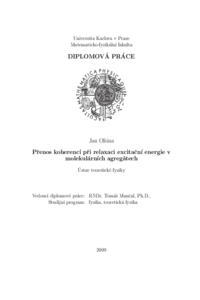Přenos koherencí při relaxaci excitační energie v molekulárních agregátech
Přenos koherencí při relaxaci excitační energie v molekulárních agregátech
rigorózní práce (UZNÁNO)

Zobrazit/
Trvalý odkaz
http://hdl.handle.net/20.500.11956/45323Identifikátory
SIS: 122697
Kolekce
- Kvalifikační práce [11325]
Autor
Vedoucí práce
Fakulta / součást
Matematicko-fyzikální fakulta
Obor
Teoretická fyzika
Katedra / ústav / klinika
Katedra chemické fyziky a optiky
Datum obhajoby
26. 4. 2012
Nakladatel
Univerzita Karlova, Matematicko-fyzikální fakultaJazyk
Angličtina
Známka
Uznáno
Klíčová slova (česky)
přenos koherencí, časový vývoj, otevřené kvantové systémy, agregáty molekulKlíčová slova (anglicky)
coherence transfer, time evolution, open quantum systems, molecular aggregatesPředložená práce zkoumá časový vývoj operátoru hustoty agregátů molekul v interakci s termodynamickou lázní s účelem najít vhodnou aproximaci pro popis vlivu přenosu koherencí na tento vývoj. Opírá se o výsledky autorem sestaveného programu pro výpočet vývoje třemi metodami - řešením konvoluční Quantum Master Equation a řešení z ní odvozených Redfieldových rovnic v Markovské aproximaci a následné Sekulární aproximaci. Na základě prezentovaných numerických výsledků programu, na příkladu trimeru, byla zkoumána teplotní závislost řešení a jeho závislost na některých dalších parametrech modelu a vliv přenosu koherencí na dílčí komponenty evolučního superoperátoru. V práci je rovněž odůvodněno, proč Markovská aproximace selhává pro široký rozsah parametrů a není proto vhodná pro popis problematiky přenosu koherencí.
We study the time dependence of the density operator of molecular aggregates in contact with thermal bath, to find a proper approximation for the description of a coherence transfer influence on this evolution. It is based on results of the computer program, written by the author of the work. The program uses three methods of evaluation - the solution of the convolution Quantum Master Equation, and solution of the derived Redfield equations in Markov and subsequent Secular approximations. The temperature dependence and dependence on other parameters of the model are discussed on the basis of the obtained numerical results performed on an example of a trimer. The influence of coherence transfer on time-evolution superoperator of the trimer is discussed as well. The reasons why the Markov approximation fails for a wide spectrum of parameters are given. It is concluded that it is not suitable for the description of coherence transfer effects.
